Today’s Current Affairs: 28th aug 2023 for UPSC IAS exams, State PSC exams, SSC CGL, State SSC, RRB, Railways, Banking Exam & IBPS, etc
Table of Contents
Coil Guns:

The Chinese navy is reportedly testing the planet’s most powerful coil gun
- Coil Guns is a type of electromagnetic weapon capable of launching projectiles with extremely high speed in the blink of an eye.
- They are also known as Gauss guns or magnetic accelerators.
- It operates on the principle of electromagnetic induction, applying the principles of electromagnetism to propel a projectile.
- Coil guns feature a series of coils arranged along the barrel of the gun, each one constituting a stage.
- Each coil is energised one after another to create a magnetic field that can levitate and propel a projectile forward.
- The projectile typically stays suspended in the centre of the coil during launch.
- The larger a coil gun, the better its ability to fire projectiles similar to those fired by traditional artillery.
- The projectile used in a coil gun is typically a ferrous or magnetic object, such as a steel ball or a specially designed ferromagnetic projectile.
- This projectile needs to have magnetic properties to interact with the electromagnetic fields generated by the coils.
20% Export Duty On Parboiled Rice:
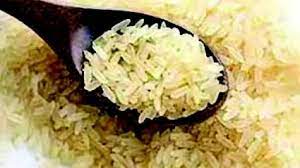
The Central Government recently imposed a 20% export duty on parboiled rice.
- Parboiled Rice also called converted rice, is partially precooked in its inedible husk before being processed for eating.
- It happens before rice is milled, that is, before the inedible outer husk is removed to yield brown rice but before brown rice is refined to make white rice.
- In some Asian and African countries, people have been parboiling rice since ancient times as it makes the husks easier to remove by hand.
- The main steps of parboiling are
- Soaking: Raw, unhusked rice, also called paddy rice, is soaked in warm water to increase the moisture content.
- Steaming: The rice is steamed until the starch converts into a gel. The heat of this process also helps kill bacteria and other microbes.
- Drying: The rice is slowly dried to reduce the moisture content so that it can be milled.
- Husking: The dried, partially cooked rice is then milled to remove the outer husk. The result is parboiled rice.
- Parboiling rice improves its texture, increases its shelf life, and provides health benefits.
- Parboiled rice is higher in fibre and protein than white rice.
- Parboiling reduces the stickiness of rice, so it yields fluffy and separate kernels once cooked.
- Additionally, parboiling inactivates the enzymes that break down the fat in rice. This helps prevent rancidity and off-flavors, increasing shelf-life
AUSINDEX-23:

The fifth edition of the biennial AUSINDEX maritime exercise between the Indian Navy and the Royal Australian Navy (RAN) was conducted from 22-25 August 23 in Sydney.
- AUSINDEX-23 is a major biennial maritime exercise, being conducted since 2015.
- The exercise will provide an opportunity for both Navies to further bolster inter-operability, gain from best practices and develop a common understanding of procedures for Maritime Security Operations.
- This year’s edition was held in Australia.
- INS Sahyadri and INS Kolkata participated in the exercise along with HMAS Choules and HMAS Brisbane from RAN.
- Besides ships and their integral helicopters, the exercise also witnessed the participation of fighter aircraft and maritime patrol aircraft.
Tele-Law 2.0:
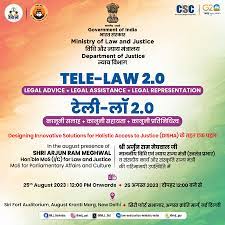
The Tele-Law 2.0 initiative was launched by the Department of Justice, Ministry of Law & Justice.
- Tele-Law 2.0 version entails the fusion of Tele-Law Services with Nyaya Bandhu pro bono legal services, a merger to further enhance citizen accessibility to legal aid.
- The integration of legal guidance, support, and representation through a single registration process stands as a testament to the commitment to nurture a digitally literate and empowered populace.
- Tele-Law programme was launched by the Department of Justice, Ministry of Law and Justice in 2017.
- This is operating under the DISHA Scheme.
- The programme connects needy and marginalised people in need of legal aid with the Panel Lawyers via video conferencing/telephonic facilities available at Common Service Centres (CSCs) situated at the panchayat level.
- In addition, the service can also be accessed through the Tele-Law Mobile App.
- Legal advice is made available to everyone under the Tele-Law service. Advice is free of Cost to those who are eligible for free legal aid under Section 12 of the LSA Act, 1987.
Seethakali:
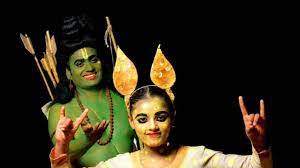
The Perinad Seethakali Sangham member group is all set to perform outside Kerala for the first time.
- Seethakali is a unique centuries-old folk art form that is believed to have originated at Perinad in the Kollam district of Kerala.
- This art form was first performed some 150 years back by the people of Vedar and Pulayar communities.
- Themes : It is based on certain episodes taken from the Indian epic Ramayana.
- Mythic characters such as Rama, Seetha, Ravana and Hanuman come alive in Seethakali performances that portray the tale of Seetha’s journey, from the time she accompanied Rama to the woods till her ascent to the heavens.
- In the early times, Seethakali was performed as part of the harvest festival Onam.
- From Atham star till the 28th day after Onam, the performers who belong to the subaltern communities go from one house to another performing this art.
- The props and instruments used during performances are all made of natural materials like bamboo and palm leaves.
- The costumes and the make-up are loud and eye-catching.
- The characters of Rama and Laxmana appear in green since the colour is used to represent gods and goddesses in Kathakali.
Gond Painting : India Gifted To The Brazilian President
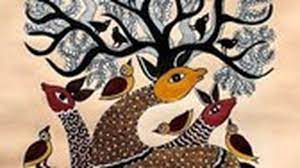
During the BRICS meeting, the Prime Minister of India gifted a Gond painting to the Brazilian president Lula da Silva.
- Gond Painting is a famous folk art of the Gond tribal community of central India.
- It is done to preserve and communicate the culture of the Gond tribal community.
- Themes: Gond tribes are highly interlinked with nature, and this appears in their paintings too. They include animals, the mahua tree, mythological stories, Hindu gods, local deities and folktales, etc.
- The artist uses his distinctive pattern and style to fill the images. These style signatures are used in collages to make a complete picture, such as dots, fine lines, curved lines, dashes, fish scales, etc.
Gond Tribe:
- The Gonds are the largest Adivasi Community in India and can be traced to the pre-Aryan era.
- The word Gond comes from Kond, which means green mountains.
- They are a heterogeneous group spreading over large areas from the Godavari gorges in the south to the Vindhya Mountains in the north.
- They live in the states of Madhya Pradesh, Maharashtra, Telangana, Andhra Pradesh, Bihar, and Odisha.
- The majority speak various mutually unintelligible dialects of Gondi.
Sodium Ion Battery:

AR4 Tech has partnered Sodion Energy of Singapore to make sodium-ion battery packs for domestic and export markets.
- Sodium-Ion Battery generate electricity through a chemical reaction.
- These are made up of an anode, cathode, separator and electrolyte.
- In a sodium-ion battery, lithium ions are replaced with sodium ions in the battery’s cathode, and lithium salts are swapped for sodium salts in the electrolyte.
- When the battery is being charged, Na atoms in the cathode release electrons to the external circuit and become ions, which migrate through the electrolyte toward the anode, where they combine with electrons from the external circuit while reacting with the layered anode material.
- This process is reversed during discharge.
- Benefits of sodium batteries
- Readily available: One of the most interesting aspects of this technology is the wide availability in nature of its constituent raw materials.
- Safety: Sodium batteries also ensure high standards of safety because cells based on this chemical element are neither flammable nor susceptible to explosions or short circuits
- Low-cost: The raw materials are readily available in nature and can be extracted at low costs and with low energy use, making sodium a material with a low impact on the environment.
- Low-temperature resistance
Emperor Penguin : Killed In The Antarctic Last Year
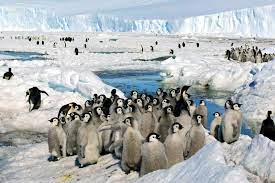
Scientists recently said that up to 10,000 young Emperor penguin chicks were reportedly killed in the Antarctic late last year when the sea ice underneath them broke off.
- Emperor Penguin is the largest of the world’s penguin species found only in Antarctica.
- Scientific Name: Aptenodytes forsteri
- They are found throughout the Antarctic continent and sub-Antarctic islands.
- In breeding months (April to November), emperor penguin colonies are found between 66° and 78° south latitude along the Antarctic coastline.
- It is the most ice-adapted of any penguin species, inhabiting pack ice and surrounding marine areas.
- They spend their entire lives on Antarctic ice and in its waters.
- They are approximately 120cm tall and weigh in at around 40 kg.
- They gain and lose weight rapidly during breeding and feeding season On average, females tend to weigh 18 kg less than males.
- They have a gray back, white belly, and orange markings behind their eyes and at the top of their chest.
- They have large stores of insulating body fat and several layers of scale-like feathers that protect them from icy winds.
- They also huddle close together in large groups to keep themselves and each other warm.
- Conservation Status:
- IUCN Red List: Near Threatened
Grand Cross Of The Order Of Honour:
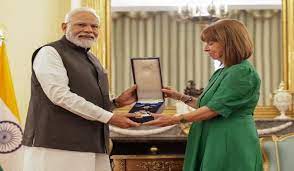
The Indian Prime minister was recently conferred with the Grand Cross of the Order of Honour by the Greek President in Athens.
- Grand Cross of the Order of Honour is the second-highest civilian honour in Greece.
- It is conferred to “eminent personalities who, by reason of their distinguished position, have contributed to enhancing the stature of Greece”.
- The Order of Honour was established in 1975.
- The head of the goddess Athena is depicted on the front side of the Star with the inscription “ONLY THE RIGHTEOUS SHOULD BE HONOURED”.
National Judicial Data Grid:

The National Judicial Data Grid (NJDG) has gained significant attention for its role in revolutionizing the way judicial proceedings are managed in India.
- National Judicial Data Grid is a database of orders, judgments and case details of 18,735 District & Subordinate Courts and High Courts created as an online platform under the eCourts Project.
- Data is updated on a near real-time basis by the connected District and Taluka courts.
- It provides data relating to judicial proceedings/decisions of all computerized district and subordinate courts of the country.
- All High Courts have also joined the NJDG through web services, providing easy access facility to the litigant public.
- Features:
- Aligned with the National Data Sharing and Accessibility Policy (NDSAP), NJDG provides an Open Application Programming Interface (API) to Central & State Governments.
- This API offers streamlined access to NJDG data using designated departmental IDs and access keys.
- This feature is intended for institutional litigants to evaluate and monitor cases, with plans to extend access to non-institutional litigants in the future.
Eastern Equine Encephalitis:

Mosquito-borne illnesses continue to pose a significant threat across various parts of the world, and one of the latest additions to this concern is the emergence of the Eastern equine encephalitis (EEE) virus in the United States.
- This rare virus has recently been reported in Alabama and New York, with serious implications for public health.
- Eastern Equine Encephalitis (EEE) is a viral disease that causes inflammation of the brain (encephalitis). It spreads to people and animals by the bite of an infected mosquito.
- EEE was first identified in horses in Massachusetts, United States, in 1831.
- EEE is caused by the Eastern Equine Encephalitis Virus (EEEV), which belongs to the genus Alphavirus and the family Togaviridae.
- EEE virus has a single-stranded, positive-sense RNA genome.
- EEEV is primarily transmitted through the bite of infected mosquitoes, particularly species belonging to the Culiseta melanura group.
- These mosquitoes feed on both birds (reservoir hosts) and mammals, including humans and horses (dead-end hosts).
- The virus does not spread between humans or from animals like horses to humans.
- The virus typically begins with high fever, headache, chills, and nausea.
- As the infection advances, more serious symptoms may develop, including seizures, disorientation, and even coma.
John Warnock : Co Founder Of Adobe System

John Warnock, co-founder of Adobe Systems and a tech industry trailblazer, has passed away at 82.
- He is renowned for his pivotal role in creating the Portable Document Format (PDF), revolutionizing document sharing.
- Initially an average student, Warnock’s passion for math was ignited by a high school teacher. He earned degrees in math and electrical engineering from the University of Utah, solving a long-standing algebra problem during his studies.
- In the realm of computer science, Warnock contributed significantly to image rendering and cutting-edge internet projects.
- Teaming up with Charles Geschke, he founded Adobe in 1982.
- Their creation, PostScript, enabled practical small-scale printing and paved the way for revolutionary PDF technology.
India Smart Cities Award Contest, 2022:

Indore has been named the best Smart City and Madhya Pradesh as the top State for their outstanding performance in the Smart Cities Mission.
- The second and third positions among cities were secured by Surat and Agra, while Tamil Nadu, Rajasthan, and Uttar Pradesh were ranked second, third, and fourth respectively in the State category of the India Smart Cities Award Contest (ISAC) 2022.
- Chandigarh won the award for the best Union Territory. The awards, are organized by the Ministry of Housing and Urban Affairs under the Smart Cities Mission.
- The awards celebrate cities, projects, and ideas that promote sustainable development in the 100 smart cities, aiming to create inclusive, safe, healthy, and collaborative urban spaces.
- The selection process involved two stages: a qualifying assessment and a proposal submission, with a total of 845 nominations from 80 smart cities leading to 66 winners in various categories.
- The Smart Cities Mission, initiated in 2015, seeks to enhance citizens’ quality of life by implementing smart solutions across sectors like infrastructure, environment, and governance.
Global Environment Facility (GEF):

The Global Biodiversity Framework Fund (GBFF) was ratified and launched at the Seventh Assembly of the Global Environment Facility (GEF) held recently.
- Governments, non-profits, and the private sector can now contribute their funds to GBFF.
- This will ensure that the world meets the goals and targets of the Kunming-Montreal Global Biodiversity Framework (GBF) formulated by the Convention on Biological Diversity (CBD) by 2030.
- As much as 20 percent of the funds would support Indigenous-led initiatives to protect and conserve biodiversity.
- It will also prioritize support for Small Island Developing States and Least Developed Countries, which will receive more than a third of the fund’s resources.
- This is the first time there would be funds channeled to non-state actors like the indigenous communities.
- Under Target 19 of GBF, at least $200 billion per year will need to be raised by 2030.
- Canada and the United Kingdom have already donated 200 million Canadian dollars and 10 million pounds respectively to the GBFF.
- After donations from Canada and the UK, $40 million is still needed to operationalize the fund by the end of 2023.
- The first GBFF Council meeting will be held in January 2024, with a view to approving the first work programme at the June 2024 Council meeting.
- The first tranche of the fund is likely to be disbursed after the council meeting to ensure that the first projects under the new Fund can be launched ahead of CBD’s CoP16.
GEF:
- Established:1991.
- It was established on the eve of the 1992 Rio Earth Summit of UNFCC.
- HQ: Washington, D.C. United States.




